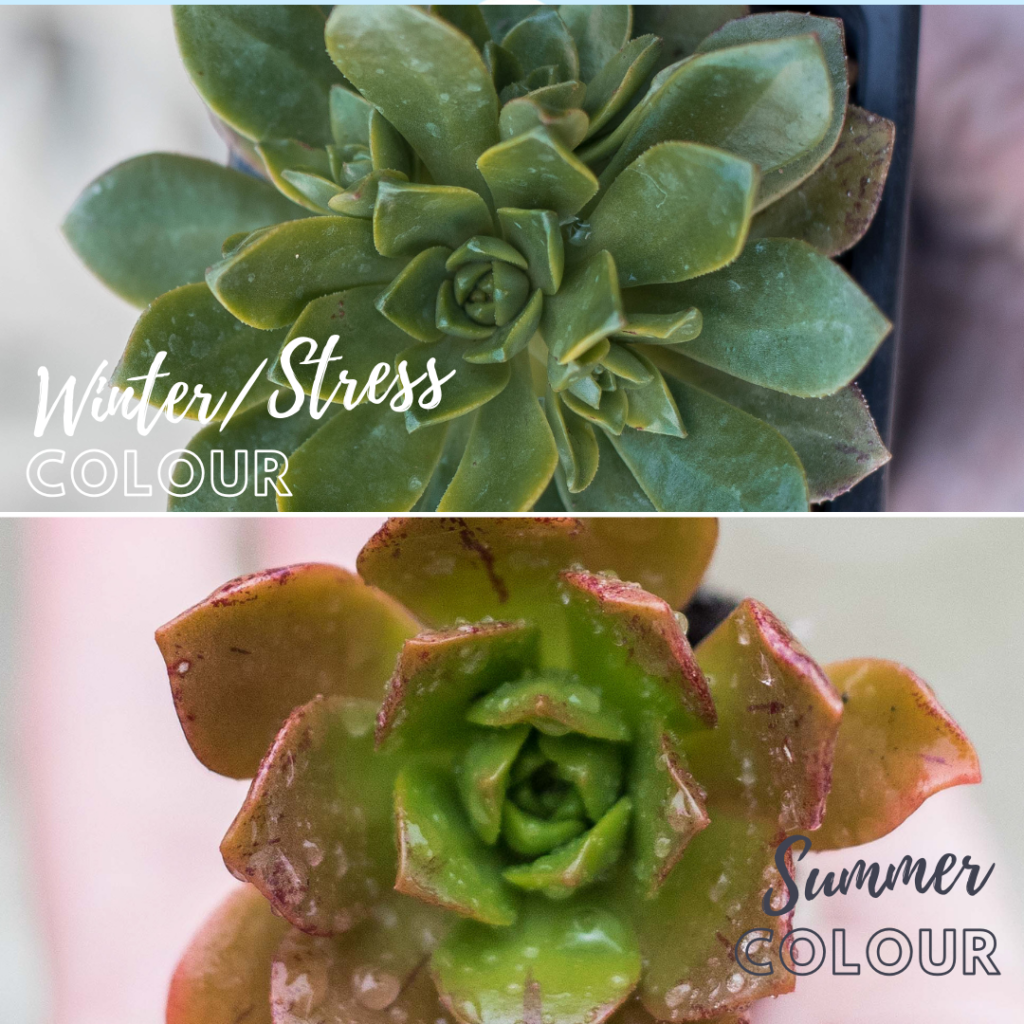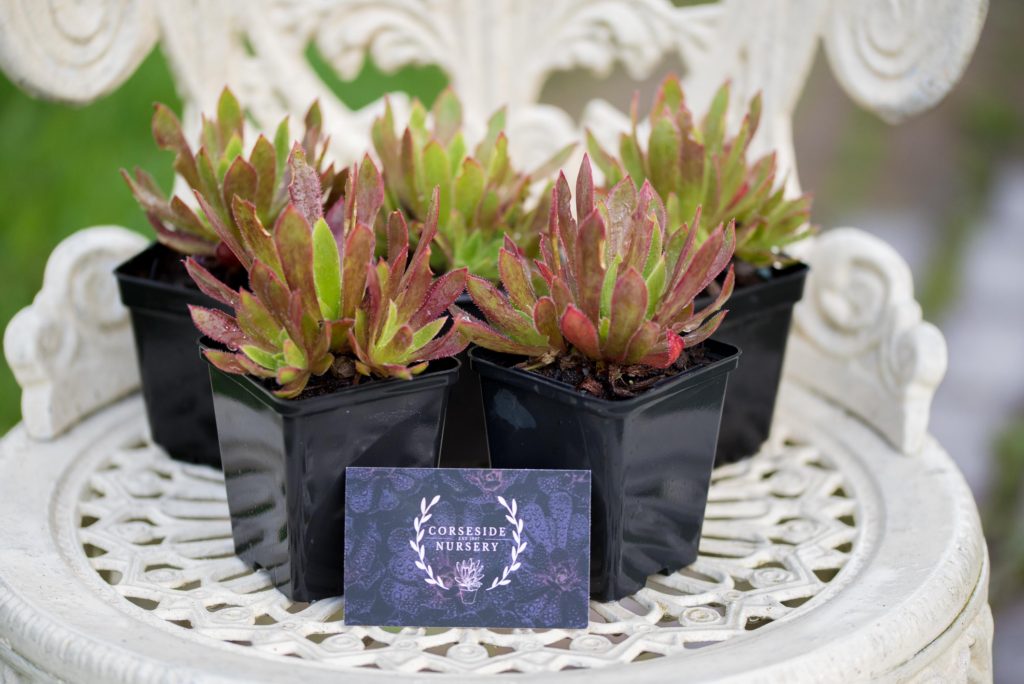All of our potted succulents are sent well-rooted and pot-bound in their Nursery pots. They are healthy, well established plants that are ready to be potted into a permanent, larger container. The plants can be housed in a pot/planter, terrarium, plant hangers, shoes… teapots! Whatever takes your fancy. Scroll below for our comprehensive succulent care guide for well-rooted potted plants.

On Arrival
As with all our plants, make sure your new succulents are put in some
good direct light to soak up after their journey in the dark. Succulents love light! Certain succulent varieties prefer an indirect light, but after being kept in a box for a few days it’s best to give them a good dose of direct sun for a few days to help them recover.
Inspect your plants on arrival. We do our very best to ensure your succulents arrive in perfect condition. If you have any concerns about their condition please contact us right away. Some succulents will shed their lower leaves in the transport and re-planting process. This is completely normal so please don’t worry. You can simple wiggle these shedding leaves and dispose of them. You can even propagate these into new plants!

Succulents change colour throughout the year as the levels and quality of sunlight change. We try to list pictures of winter and summer colour variations where possible to help you understand your plant’s characteristics when choosing
Choosing a home for your succulent
You can choose whether to pot your new succulent into a decorative pot of similar size, or a slightly bigger pot to encourage more growth. Our potted succulents will be quite happy if left in their Nursery pots for the foreseeable future if you’d prefer. It’s worth noting that most succulents are pretty happy being kept in a smaller pot. As long as they have sufficient water, you can keep them small if you so desire.
Most growers will advise you to pick a container with holes in the bottom to ensure good water drainage from the pot. Whilst this is excellent advise, we’ve had lots of success growing succulents in containers without holes too. If you want to go down this route, the key is to be extra cautious with watering so that there is never a puddle in the bottom of the container. A moisture meter might come in handy here.

A note on Coastal Hardy Plants
If you’ve purchased from our Coastal Hardy collection, these plants are quite happy to go straight into the ground outside during the warmer months (April to October in the UK). In the colder months, it’s best to keep them in a protected environment as they won’t have had much time to establish themselves in the ground before the cold sets in. By the following winter, they will be happy to go a full winter outside in a UK coastal garden.
Succulent soil?
What soil should I use for my succulents? This is a very common question we get asked.
Succulents like to be in soil that allows water to drain freely from around the roots. They like a good drink, but they don’t like to be sat in water. For this reason, it is advised to mix your normal potting soil with material that has larger components such as crushed shell, gravel, perlite or pumice. All of our succulents are grown in locally sourced, peat free compost. We tend to use sand and crushed shell with most of our plants; 2 thirds soil to 1 third drainage. There is no right or wrong here; you are just trying to make it easier for the water to drain away from the soil. Succulents don’t like soggy bottoms or wet feet!

Watering your succulents
When your new plant arrives it is best to check the moisture level in the pot before deciding to water. We often let the plants dry out before posting, but sometimes your order may come just after a watering and so the soil may be quite moist still.
You can check the moisture level of the soil by simply sticking your finger into it. You can also pull your plant out of it’s Nursery pot to inspect it more closely. Succulents do like watering but need to dry out completely between each watering.
The trick with succulents is to try and mimic the droughts and monsoons they experience in their native environments. The leaves of succulents are designed to soak up extra water to keep them going through periods of drought, so their requirements tend to be much less than traditional house plants. They thrive on neglect! Treat them mean to keep them keen.
If in doubt, stand the plant in a small dish of water for a few hours to allow it to soak up all it needs.
If you decide to pot your plant into a larger container, it is best to give your succulents a good soak when they are in position. The new soil will likely be very dry so it’s good to have this initial burst of water. If you’ve chosen a pot with drainage holes in the bottom, standing your pots on a watering tray is the best way to monitor their water requirements. If you ever see a puddle in the tray, there is too much water in the pot. If the tray has been empty for a while, you can add some water to it and allow the plant to soak up any it needs overnight before pouring excess away.

A note on Seasons and the
Growing Environment
It is worth noting that growth rates and watering requirements are going to change quite significantly throughout the year in the UK. Succulents require much more water in the summer months and some may even need protection from harsh midday heat. Be mindful of this when reading advice. You need to adjust your care to suit your own needs. A succulent growing on a windowsill right next to a radiator is going to need much more water than one growing in a cold utility room for example.

Succulent Food
Should you feed your succulents?
There is a lot of talk about succulent feed. To be completely honest, we’ve never fed our plants with anything other than water, soil and sunlight (and the odd conversation to keep them sane) so we don’t advise this as a necessary step.

We’ve created a facebook group called ‘Secrets of Succulents’ for our succulent obsessed community and would love for you to come and join in the conversation here. This is a safe space to ask questions and troubleshoot and a place to share your wins and successes. We’d love to see how you’re getting on with your new plant babies.
Thanks for reading, and happy growing!



Pingback: How to grow your succulent cuttings - Corseside Nursery Pembrokeshire - Buy Succulents Online UK plants by post peat free delivery organic Aeonium Echeveria Aloe Crassula House Plant order
Hi Sandra and Rosie,
Many thanks for the super Aloe Striatula which have arrived safely.
Have a lovely Summer, best wishes Pete Lovell.
Awww you’re very welcome! Thanks for shopping with us Pete!
Rosie x
Hi both
Thank you for my order, they have just arrived safe and well.
May have to pay you a visit if we can 😬 as we are not really that far from you.
Great excuse to bring puppy out for a beach walk.
Best wishes
Cheryl
Aww thanks for messaging. Glad to hear your succulents arrived safely. And yes! You’re welcome anytime for a visit. We do ask visitors to ring ahead to check we’re here though as we’re often out on deliveries or sneaking down the beach! Happy Growing
Rosie
Corseside Nursery
The three plant starter pack have arrived safe and sound and are at the moment sitting on the windowsill soaking up the sun. They have brightened up an empty sill.
Aww that’s lovely to hear! I’m sorry I missed your reply when you posted. I hope your plants are growing well 🙂
Rosie x
I have an Echeveria “Compton Carousel”, it was bought some years ago on a nursery visit (not yours!), we’ve kept it going from cuttings, but we’re now down to one plant & it’s not very happy. The leaves are sticky, and appear to be covered with tiny insects, I was wondering whether I could us a cotton-wool bud to wipe them with something – meths, perhaps? I tried spraying with a water/detergent mix, but that didn’t make any difference. I would be grateful for any advice you could give me.
Regards,
Elaine.
Hi Elaine, sorry to hear about your pests. Unfortunately this is one of the hardest types of Echeveria to keep happy and I think that’s why it’s quite rare and costly. We really only use water and washing up liquid in a spray bottle that tends to get rid of most common succulent pests. I know a lot of people swear by cotton wool and pure alcohol as a more severe treatment. I don’t think this effects the plant.
Very pleased with my Aeonium Velour, which, is a present off my Niece …it looks happy and healthy on the windowsill, thank you for all your care 👍👍
Thank you for your lovely comments. So pleased you are enjoying your new plant 🙂
Rosie
I too am pleased with my Aonium Velour …it too looks happy on the windowsill thank you.
That’s lovely to hear Carol! Happy growing! 🙂
Hi, i have just received my Crassula Ovata Gullum and they look great after travelling, i have watered them slightly and put on kitchen window cill ready to repot in baskets outside when warmer, waiting about one week before doing this hoping the weather will improve, will start them of in Greenhouse to climitize them, thank you for your quick delivery and care in packing.
Aww thank you for your feedback. So pleased you are enjoying your new plant. Happy Growing!